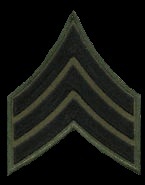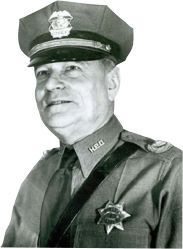
SERGEANT WILLIAM A. GABRIELSON
SDPD 1908 - 1915
12/04/1885 - 09/10/1978

One of the marvels of the 20th century has been the development of forensic science. Scotland Yard first suggested using fingerprints as a form of identification in the 1800’s, yet despite the endorsement of one of the world’s finest law enforcement agencies, the idea wasn’t, at first, widely accepted in the United States.
A more popular form of identification was already in place, the Bertillon system. The system was one of measurements of key areas of the body. The theory being that once a person is an adult those measurements never change and are unique to the individual.
That theory was blown apart when Will West was booked into the Federal Prison at Leavenworth Kansas. A Bertillon examination concluded that not only had Will Ward previously been an inmate there, he still was. It was only after guards physically checked that they discovered there were two men named Will West and their Bertillon measurements were identical.
The amazing Will West coincidence would become one of the most deciding factors in the use of fingerprints in the US. Wanting to avoid a Leavenworth disaster, Keno Wilson ordered police clerk William Gabrielson, to begin building an identification bureau. The planning called for Gabrielson to compile photographs, fingerprint cards and (just in case) Bertillion measurements of anyone arrested. Very quickly officers discovered how helpful it was to be able to go to the bureau and check the arrest record of a person they had in custody. It also proved valuable when they had arrested an individual that refused to provide a name or his criminal history.
By 1914 the Identification Bureau had several thousand records and was a model for law enforcement agencies on the west coast. Still headed by now Sergeant Gabrielson, the bureau stopped using the Bertillion system as a form of identification and now relied on fingerprints alone.
Sergeant Gabrielson left the SDPD in 1915 and headed north where he became a sergeant for the Berkeley Police Department. He later left that agency to become chief of the Monterey Police Department.
On 08/12/1932, he was sworn in as Chief of the Honolulu Police Department, a position that afforded him an eye witness view of the December 7, 1941, bombing of Pearl Harbor. He remained there until 05/31/1946. Later in life he served as a deputy sheriff in Northern California and even worked as a clerk in a plumbing and heating company in 1957.
William Gabrielson died in San Luis Obispo California on September 10, 1978.

THE THIN BLUE LINE
SON OF JAILER
Basic information is provided as a courtesy and is obtained from a variety of sources including public data, museum files and or other mediums. While the San Diego Police Historical Association strives for accuracy, there can be issues beyond our control which renders us unable to attest to the veracity of what is presented. More specific information may be available if research is conducted. Research is done at a cost of $50 per hour with no assurances of the outcome. For additional info please contact us.